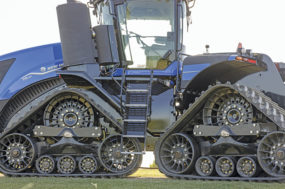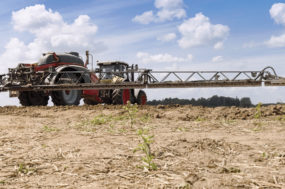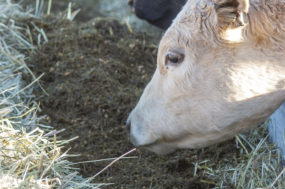1. toxic prussic acid potential and management of frosted sudangrass and sorghum sudangrass hybrids
2. frosted alfalfa and toxicity to grazing animals
3. harvesting the last alfalfa cutting
Managing frosted sorghum sudangrass and sudangrass
The potential for prussic acid poisoning and management suggestions are related both to the size of the plant when frosted and the extent of frost damage. Producers should be aware that the risk of damaging levels of prussic acid is very unlikely.
Prussic acid, more correctly called hydrocyannic acid (a cyanide-based compound) is formed in sudangrass or sorghum sudangrass hybrids which are severely stressed or frost-damaged. The hydrocyannic acid develops within a few hours after the frost and usually dissipates within a few days.
The safest management is to remove cattle and sheep from frosted fields for several days. Livestock can be returned to frost-injured sudangrass that is 18 inches or taller and sorghum sudangrass 30 inches or taller after about three or four days.
If the grass was shorter than these heights when frost-injured, withhold cattle and sheep for 10 days to two weeks following the frost to avoid problems.
Then watch for new shoot regrowth (tillers or suckers) on partially frost-killed plants. Direct grazing of these fresh new shoots can be toxic too. Where new shoots appear following frost, avoid grazing until two weeks after the “killing” frost that kills the new shoots.
Prussic acid poisoning is not a common occurrence. Very few verified cases are reported by veterinarians. But consider the recommendations above to be at the low risk or conservative level. If in doubt, move the livestock to another type of forage.
Livestock can then be returned to the sudangrass or sorghum sudangrass fields following a “killing” frost and appropriate post-frost delay period.
Frost-damaged sudangrass or sorghum sudangrass hybrids can be cut and stored as silage. Hydrocyannic acid is dissipated during wilting and partially during the ensiling process. Observe proper ensiling technique, particularly moisture content, when ensiling these crops.
Sudangrass and sorghum sudangrass hybrids are difficult to dry thoroughly enough for safe storage as dry hay. As with wilting and ensiling, most if not all of the hydrocyannic acid is dissipated in the drying process.
Producers who want to get frosted sudangrass or sorghums tested for hydrocyannic acid content should first contact a forage or plant tissue analysis laboratory near you and ask whether they can do the test for you and what they recommend as the proper procedure for collecting, handling and shipping of the sample to the lab.
Frosted alfalfa toxicity
Frost-injured alfalfa, clovers and the commonly used perennial cool-season forage grasses do not have the potential to form hydrocyannic acid, are not considered toxic and can be safely grazed or harvested for hay or silage following a frost.
There is probably a slightly higher bloat risk for grazed alfalfa and white clover the first few days after a frost. Follow normal bloat-preventing grazing management when grazing alfalfa and clover.
The literature notes that Indiangrass (a perennial, warm-season prairie grass) and birdsfoot trefoil have a low potential to form hydrocyannic acid. Actual problem cases using these forages should be considered extremely rare and of minimal concern.
Harvesting the last alfalfa cutting
There is not a simple answer to the question of when to harvest the last alfalfa cutting. In general, it will depend whether the frwost was a “killing frost” or not.
A “killing frost” is not the first light frost of the season; rather, it is a 23 or 24ºF freeze that lasts for four to six hours or so.
If the producer does not need the forage, it is best for the alfalfa plants to leave them uncut and standing through the winter.
If it was the hard, killing freeze, and the producer needs the forage, harvest as soon as possible after the freeze to salvage as much of the nutritive value as possible. The longer the delay, the greater will be the weathering damage and leaf loss from the standing frosted plants.
If the frost was a light, non-killing freeze, the tops of the alfalfa plants will be visibly damaged but will not likely stop the plants’ growth for the season.
The damaged tops will deteriorate in nutritive quality for the remainder of the autumn, but the plant will still be attempting to regrow from crown buds and will be using stored sugars.
The best management for the plant is to allow it to continue to grow using whatever green leaf area it still has until the hard, killing freeze. Then if the producer needs the forage, it can be cut wand harvested for hay or silage, or grazed.
Alfalfa plants cut immediately after a partial freeze (non-killing frost) and which experience further normal growing temperatures will start new regrowth from crown buds, using accumulated proteins and carbohydrates that would otherwise be used for overwintering and regrowth the following spring.
When these late-recovering plants experience a killing freeze a few days or weeks later, they will be physiologically weaker and more susceptible to winter injury. FG
—Excerpts from Iowa State University Extension website










